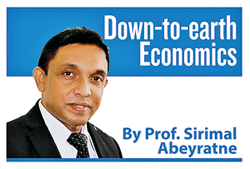“Penny wise, pound foolish”
View(s):What I found was amazing. One response stood out: “If we implement the FTA with Thailand, motor cars manufactured there will enter Sri Lanka duty-free.”
“Wow… That sounds great! Sri Lankans could finally buy cars at more affordable prices” I said.

File picture of an apartment complex in Singapore, a small nation that has soared above others in development.
Thailand has rapidly evolved into a major automobile manufacturing hub. Dozens of global automakers now operate there, including all the big Japanese names—Toyota, Honda, Isuzu, and Mitsubishi.
Of course, the import duty on motor vehicles is about 30 per cent, which would be phased out under the FTA. But other levies like excise duty and VAT would still apply. So, while prices might drop, they would not plummet.
Daikin in India
Daikin Airconditioning India Pvt Ltd is a subsidiary of Daikin Industries, a Japanese manufacturing giant founded a century ago in Osaka. Over the decades, Daikin has emerged as a global leader in Heating, Ventilation, and Air Conditioning (HVAC) systems, with around 100 subsidiaries worldwide and a customer base spanning more than 170 countries.
In a strategic move, the company recently inaugurated its third manufacturing facility in Sri City, Andhra Pradesh, complementing its two existing plants in Neemrana, Rajasthan. This expansion marks a significant step toward Daikin’s ambitious goal: to transform India into its “global export hub” by 2030. The country’s vibrant market dynamics and skilled labour force have proven to be a perfect match for Daikin’s global vision.
To be clear, my intention is not to delve into the specifics of Daikin’s investment. It is just one among countless examples of foreign ventures flourishing across India. I chose it simply to pose a timely and thought-provoking question:
 “Why, despite its complex socioeconomic and political landscape, does India continue to attract global investment with such confidence?”
“Why, despite its complex socioeconomic and political landscape, does India continue to attract global investment with such confidence?”
India is not without its historical challenges. Its regulatory and political frameworks can be intricate, and progress is often uneven. Yet, the undeniable truth is that international companies are increasingly betting on India’s future—and doing so with conviction.
Global business giants
Over the past 20 years, India has emerged as a magnet for global business giants across a wide spectrum of industries. From tech titans to pharmaceutical powerhouses, the country has attracted a remarkable wave of foreign investment.
In the digital and technology space, companies like Apple, Google, Microsoft, Amazon, Meta (formerly Facebook), and Foxconn have established a strong presence. The automobile sector has seen major players such as Toyota, Volkswagen, Skoda, Hyundai, and Kia set up operations, while Tesla continues to explore entry into the Indian market.
Retail and consumer goods giants—including Walmart, IKEA, Unilever, and Nestlé—have also made significant inroads. In the financial and investment domain, firms like Goldman Sachs, JP Morgan Chase, Blackstone, KKR, and SoftBank are actively doing business in India.
The telecom sector features global names such as Vodafone, AT&T, Siemens, and GE. Meanwhile, pharmaceutical leaders like Pfizer, Johnson & Johnson, Roche, and Novartis are contributing to India’s growing healthcare and biotech landscape.
This diverse influx of global players underscores a powerful trend: despite its complexities, India continues to be seen as a land of opportunity, innovation, and long-term growth.
Beyond big population
India has rapidly emerged as Asia’s newest investment hotspot, attracting billions of dollars in foreign direct investment (FDI) each year—and the momentum is only growing. During the last five years alone (2020-2024), the country received an impressive US$ 214 billion in FDI, accounting for nearly 40 per cent of its total FDI stock.
Why is India so attractive to global investors now? While there’s no single answer, many would quote one factor that tops the list—population size. With nearly 1.5 billion people, India has overtaken China to become the most populous country in the world.
I often have a counterpoint: Singapore, with a population of just 5.5 million, attracted over $ 623 billion in FDI during the same five-year period. Clearly, it’s not just about numbers.
Even if we refine the argument, focusing on India’s affluent consumer base with about 430 million people— this is larger than the entire population of the United States. By 2030–31, this figure is projected to reach 715 million, nearly 47 per cent of the population.
This expanding middle class is being fuelled by rising incomes, rapid urbanisation, and improved access to education and digital technology. It’s not just a demographic shift—it’s a transformation of consumer power, and global investors are taking notice.
Smaller economies
While the size of a local market is certainly important in attracting FDI, a smaller population or a limited middle-class segment is not necessarily a barrier to FDI. The success stories of countries like Singapore and other small economies have already proven this point.
Take Singapore, for example—a compact city-state whose market reach is fundamentally global. For smaller nations, going global is not a choice; it is a necessity.
They must look beyond domestic borders not only to sell their products but also to source essential inputs like labour. In fact, over 40 per cent of Singapore’s workforce consists of foreign-originated nationals. Dubai takes this even further, with more than 80 per cent of its labour force coming from abroad.
These examples underscore a powerful insight: FDI flows are shaped not just by population size, but by strategic openness, global integration, and the ability to leverage both domestic strengths and international networks.
First-best and the second-best
While the domestic market plays a vital role in economic development, it is not the sole driver of growth. In today’s interconnected world, domestic markets are increasingly intertwined with global markets that span across continents. To tap into this broader opportunity, countries typically adopt two complementary strategies: the first-best and the second-best approaches.
The “first-best” strategy involves unilateral policy reforms aimed at creating an open economy that integrates seamlessly with the global system. Under this approach, countries do not wait for reciprocal action—they open their markets independently, confident that openness will attract investment and trade. Singapore has long exemplified this model, maintaining a consistently open economy.
Interestingly, Sri Lanka also embraced this path early on. In 1977, while neighbouring countries were still pursuing closed economic models, Sri Lanka initiated trade liberalisation and began opening its economy to the world.
The second-best strategy is reciprocal. It involves negotiating and entering into FTAs, where countries mutually agree to reduce trade barriers. These agreements are especially effective when built upon a foundation of open economic policies—making them a natural complement to the first-best approach.
Connecting through FTAs
India embarked on its unwavering policy reform journey in 1990. Over the past 35 years, governments and leaders have come and gone, but the reform process has remained consistent—steadily building investor confidence and positioning India as a reliable destination for global capital.
Since 2000, India has also leaned heavily into the second-best strategy of global integration: forging FTAs with individual countries and regional blocs. It began with an FTA with Sri Lanka in 1999 and has since expanded its network to include over 25 countries across Asia Pacific, Europe and South America.
These agreements span both emerging and advanced economies, including Singapore, South Korea, Japan, Malaysia, Australia, the UAE, the UK, Norway, and Switzerland. A major FTA with the European Union—covering all its 27 member states—is currently under negotiation. Most of these FTAs are also comprehensive, encompassing trade in goods and services, investment flows, and economic and technical cooperation.
So, here’s a timely question: If a global investor is seeking a dynamic market in South Asia with worldwide free market access and seamless input supply chains, where is the most promising investment enclave? Obviously, it is India.
Sri Lanka’s FTA trajectory
Sri Lanka too started off its FTA trajectory together with India signing the same FTA in 1999. Yet, while India has expanded its FTA network across continents, Sri Lanka remains stuck at square one. To date, it has failed to establish meaningful free market access beyond the South Asian region. Even within South Asia, India stands as the only substantial market partner for Sri Lanka.
Given this limited reach, it is no surprise that FDI inflows to Sri Lanka remain modest. A significant portion of these inflows are also driven by government-led initiatives, while independent, market-driven FDI remains even smaller. If Sri Lanka hopes to achieve a breakthrough, it must address several structural challenges: a weak input base, limited market size, and inconsistent policy frameworks. Above all, it needs to foster a more investor-friendly climate through bold and sustained reforms.
The experience of small countries like Singapore proves that smart policy choices can overcome market limitations. By embracing both first-best (unilateral openness) and second-best (reciprocal FTAs) strategies, Singapore has positioned itself as a global investment magnet.
Ultimately, FDI flows to places where capital feels safe, returns are promising, and systems are predictable. For Sri Lanka to compete, it must offer the same.
(The writer is Emeritus Professor at the University of Colombo and Executive Director of the Centre for Poverty Analysis (CEPA) and can be reached at sirimal@econ.cmb.ac.lk and follow on Twitter @SirimalAshoka).
Hitad.lk has you covered with quality used or brand new cars for sale that are budget friendly yet reliable! Now is the time to sell your old ride for something more attractive to today's modern automotive market demands. Browse through our selection of affordable options now on Hitad.lk before deciding on what will work best for you!


